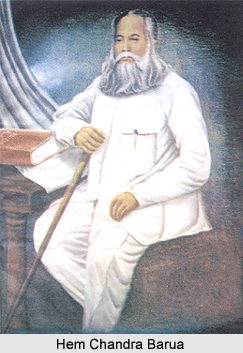 Hem Chandra Barua has rightly been called the father of modern Assamese language and literature. Hem Chandra Barua is known for his compilation of first dictionary in Assamese language known as Hemkosh. He brought great devotion to his work coupled with organisation, assiduity and diligence. His Grammar of the Assamese Language (1856) and Hemkos (Dictionary), the first standard work on lexicography, laid a sure foundation for the future development of the language. The language now had a systematic grammar which among other things laid down clear-cut rules for spelling and syntax, leaving no room for obscurity and confusion. The Hemkos became a standard lexicon giving the etymology of words and their English equivalents and clearly setting forth what each word in the Assamese language really meant. His Grammar and Dictionary remain even today standard texts.
Hem Chandra Barua has rightly been called the father of modern Assamese language and literature. Hem Chandra Barua is known for his compilation of first dictionary in Assamese language known as Hemkosh. He brought great devotion to his work coupled with organisation, assiduity and diligence. His Grammar of the Assamese Language (1856) and Hemkos (Dictionary), the first standard work on lexicography, laid a sure foundation for the future development of the language. The language now had a systematic grammar which among other things laid down clear-cut rules for spelling and syntax, leaving no room for obscurity and confusion. The Hemkos became a standard lexicon giving the etymology of words and their English equivalents and clearly setting forth what each word in the Assamese language really meant. His Grammar and Dictionary remain even today standard texts.
Early Life of Hem Chandra Barua
Hemchahdra Barua, a descendant of an orthodox Brahmin family of Sibsagar, learnt English secretly at home with the assistance of the missionaries. He was a gifted contributor to the Arunoday. He began his literary career as a writer of school texts, of which the Adipath and the Pathmala remain even today two of the best specimens of Assamese prose style. Of his other works, the Bahire Ran Can Bhitare Kova Bhaturi (All that glitters are not gold) is a novelette where the satiric or critical spirit was for, the first time introduced in Assamese literature. Though himself a high-class Brahmin, Hemchandra Barua was an outspoken critic of Hindu orthodoxy and was pitiless in exposing its many social and moral hypocrisies and hide-bound conventions. He mercilessly lays bare in the novelette the immoral practices of Gobardhan Satradhikar, a Hindu pontiff, who professes to be religious but is in fact lecherous, secretly indulging in all sorts of immoral liaisons, and even going so far as to seduce the wife of a low caste disciple of his.
Literary Significance of Hem Chandra Barua
In 1861 was published his Kaniyar Kirtan - a social farce dealing with the evil effects of opium-addiction. Incidentally, he also exposed in this farce how in the name of religion the Gosains and Mahantas, who were entrusted with religious administration, perpetrated immoralities, and how Assamese peons of the British in their overweening pride used Hindusthani in preference to their mother tongue for no other purpose than to mystify the common folk and to cut impressive figures. The whole farce is full of bitter satire and biting sarcasm. Though somewhat lacking in dramatic vigour, its reformatory appeal and entertaining dialogue make Kaniyar Kirtanan outstanding literary achievement. Indeed, it actually won a prize from the Government. In the evolution of Assamese prose style Hemchandra Barua`s has been a profoundly wholesome influence.
Hem Chandra Barua (1890-1958) shows deep understanding and absorption in his stories presenting rural life very skilfully. Setting and characterisation played an important part in his plays. He heightened dramatic effect by making a psychological mystery of each case and wrapping it in veils of psychoanalytical speculation. This is clearly seen in Jahara which is a story that has made a serious application of Freudian psychopathological analysis.
His other works include Chapania and Morgharkhan. His Navagraha (1954) is classified as belles letters though in real it is not so. It is a collection of popular essays on science told in the belles` letters approach. He was the President of the Assam Sahitya Sabha in 1972. His literary works include: Adhunik Sahitya, Sagar Dekhicha?), Balichanda, San Mihali, Cupid Aru Psyche, Ranga Karabir Phul, Kannaki, Ei Git, Idle Hours, Sahitya Aru Sahitya, Achuphul, Man Mayuri, Bahagate Pati Jaon Biya and Smritir Papari.
In 1861 was published his Kaniyar Kirtan - a social farce dealing with the evil effects of opium-addiction. Incidentally, he also exposed in this farce how in the name of religion the Gosains and Mahantas, who were entrusted with religious administration, perpetrated immoralities, and how Assamese peons of the British in their overweening pride used Hindusthani in preference to their mother tongue for no other purpose than to mystify the common folk and to cut impressive figures. The whole farce is full of bitter satire and biting sarcasm. Though somewhat lacking in dramatic vigour, its reformatory appeal and entertaining dialogue make Kaniyar Kirtanan outstanding literary achievement. Indeed, it actually won a prize from the Government. In the evolution of Assamese prose style Hemchandra Barua`s has been a profoundly wholesome influence.



















